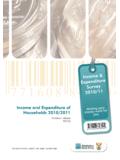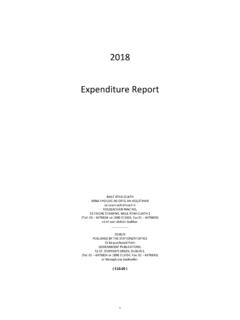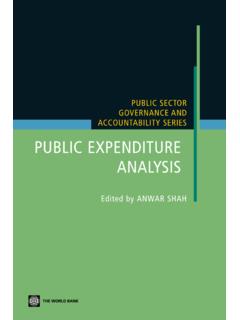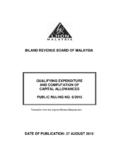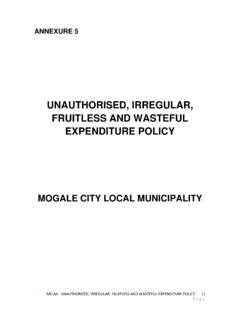Transcription of UPDATED GUIDELINE ON IRREGULAR EXPENDITURE
1 UPDATED GUIDELINE ON IRREGULAR EXPENDITURE OFFICE OF THE ACCOUNTANT-GENERAL APRIL 2015 GUIDELINE ON IRREGULAR EXPENDITURE 2 | P a g e TABLE OF CONTENTS PURPOSE .. 4 APPLICABILITY .. 4 UPDATE OF THE GUIDELINE ON IRREGULAR EXPENDITURE .. 4 PRINCIPLES FOR THE TIMING AND RECOGNITION OF IRREGULAR EXPENDITURE .. 4 FINANCIAL MISCONDUCT .. 6 UNAUTHORISED EXPENDITUREVERSUS IRREGULAR EXPENDITURE .. 7 Departments .. 7 Public Entities listed in Schedules 3A and 3C to the 7 ACCOUNTING POLICY FOR IRREGULAR EXPENDITURE .. 7 PROCEDURES FOR THE TREATMENT OF IRREGULAR EXPENDITURE .. 9 27. Procedures for the discovery, investigation and reporting of IRREGULAR EXPENDITURE .. 9 Discovery of IRREGULAR EXPENDITURE .. 9 Enquiry or investigation into the alleged IRREGULAR EXPENDITURE .
2 9 Confirmation and reporting of IRREGULAR EXPENDITURE .. 9 28. Procedures for raising a receivable (debtor)and the recovery of IRREGULAR EXPENDITURE .. 10 Recovery of IRREGULAR EXPENDITURE .. 10 Determination of an official liable in law .. 10 Confirmation of a person liable in law .. 11 IRREGULAR EXPENDITURE written off .. 12 29. Procedures for the condonation of IRREGULAR EXPENDITURE .. 12 RELEVANT AUTHORITY .. 13 DELEGATIONS OF AUTHORITY .. 13 EXAMPLES OF IRREGULAR EXPENDITURE .. 14 RECORDING IN THE IRREGULAR EXPENDITURE REGISTER .. 15 RECORDING OF IRREGULAR EXPENDITURE IN THE ANNUAL FINANCIAL STATEMENTS .. 16 CONTRACTS ARRANGED BY OTHER INSTITUTIONS .. 19 National Government .. 20 Lease contracts arranged by the Property Management Trading Entity (PMTE).
3 20 GUIDELINE ON IRREGULAR EXPENDITURE 3 | P a g e Construction contracts arranged by the Property Management Trading Entity (PMTE) .. 20 Provincial Government .. 20 Lease contracts arranged by the Provincial Department of Public Works .. 20 Construction contracts arranged by the provincial Department of Public Works .. 21 National and provincial government .. 21 Transversal term contracts arranged by Treasury or State Information Technology Agency (SITA) .. 21 Institutions that are not represented in the Bid Committees .. 21 Institutions that are represented in the Bid Committees .. 22 Contracts which are specific to the procuring institution (Client) .. 22 Other contracts which are specific to the procuring institution (Client) including capital projects performed through the Department of Public Works, Independent Development Trust and other Mandated Institutions.
4 23 STATUS OF THE TENDER BOARD ACT, 1968 ANNEXURE A .. 24 STEP BY STEP TREATMENT OF IRREGULAR EXPENDITURE ANNEXURE B .. 26 ACCOUNTING FOR IRREGULAR EXPENDITURE ANNEXURE C .. 27 PROCEDURE FOR THE TREATMENT OF IRREGULAR EXPENDITURE ANNEXURE D .. 28 PROCEDURE FOR THE TREATMENT OF IRREGULAR EXPENDITURE ANNEXURE E .. 29 REGISTER OF IRREGULAR EXPENDITURE (EXAMPLE ONLY) ANNEXURE F .. 30 GUIDELINE ON IRREGULAR EXPENDITURE 4 | P a g e PURPOSE 1. The purpose of this GUIDELINE is to provide clarity on the procedures1 to be followed when dealing with the identification and application of IRREGULAR EXPENDITURE , defined in section 1 of the Public Finance Management Act (PFMA), 1999 as EXPENDITURE other than unauthorised EXPENDITURE , incurred in contravention of or that is not in accordance with a requirement of any applicable legislation, including (a) this Act; or (b) the State Tender Board Act, 1968 (Act No.)
5 86 of 19682), or any regulations made in terms of that Act; or (c) any provincial legislation providing for procurement procedures in that provincial government. 2. This Act in section 1 of the PFMA includes any regulations and instructions issued in terms of section 69, 76, 85 or 91. APPLICABILITY 3. This GUIDELINE applies to all: (a) Departments; (b) Government Components; (c) Trading Entities; (d) Constitutional Institutions; and (e) Public Entities listed in Schedule 2 and 3 to the PFMA. UPDATE OF THE GUIDELINE ON IRREGULAR EXPENDITURE 4. This GUIDELINE is an update of the GUIDELINE on IRREGULAR EXPENDITURE issued on 28 May 2014 and takes effect from 01 April 2015. PRINCIPLES FOR THE TIMING AND RECOGNITION OF IRREGULAR EXPENDITURE 5.
6 For a department or a government component3 to incur IRREGULAR EXPENDITURE , the transgression must be linked to a financial transaction. Although a transaction, condition or an event may trigger IRREGULAR EXPENDITURE , a department or a government component will only record IRREGULAR EXPENDITURE when a payment pertaining to the 1 This GUIDELINE does not prescribe any new principle or procedure related to the identification and application of IRREGULAR EXPENDITURE but is merely a consolidation of provisions that are currently contained in Practice Note 4 of 2008/2009 on IRREGULAR EXPENDITURE . 2 Annexure A provides for the status of the State Tender Board Act, 1968 (Act No.)
7 86 of 1968) 3 This provision is applicable to those government components that are currently applying the modified cash basis of accounting and the Modified Cash Standard issued by the National Treasury. GUIDELINE ON IRREGULAR EXPENDITURE 5 | P a g e non-compliance is actually made ( when the EXPENDITURE is recognised in accordance with the recognition principles contained in the Modified Cash Standard). 6. A constitutional institution, a government component required to comply with the standards of GRAP, a trading entity or a public entity listed in Schedules 2 or 3 to the PFMA shall incur IRREGULAR EXPENDITURE when a transaction, condition or an event linked to the transgression that has financial implications is recognised as EXPENDITURE in the Statement of Financial Performance in accordance with the Standards of Generally Recognised Accounting Practice (GRAP) or the International Financial Reporting Standards (IFRS).
8 7. Figure 1 below provides for the non-compliance and recognition of IRREGULAR EXPENDITURE as referred to in paragraph 5 and 6 above. The diagram provides an indication that, if non-compliance is corrected or condoned prior to any EXPENDITURE being incurred in terms of the relevant accounting standards, such a transaction, condition or event will not result in IRREGULAR EXPENDITURE . 8. For the purposes of determining whether IRREGULAR EXPENDITURE has been incurred, there must first be a transgression of a provision contained in:- (a) the PFMA; (b) the Treasury Regulations; (c) a National Treasury Instruction, issued in terms of section 76 of the PFMA; (d) a Provincial Treasury Instruction issued in terms of section 18(2)(a) of the PFMA; or (e) any other applicable legislation.
9 9. When applying the test to determine whether IRREGULAR EXPENDITURE has been incurred, it must be clear that the contravention must relate to how the transaction, condition or event was entered into and by whom as opposed to when the transaction, condition or Transgression Expense recognised in terms of GRAP/IFRS Expense recognised in terms of Modified Cash Standards Non-compliance IRREGULAR EXPENDITURE IRREGULAR EXPENDITURE Non-compliance GUIDELINE ON IRREGULAR EXPENDITURE 6 | P a g e event was entered into. For example, non-compliance with the requirement to pay an invoice within 30 days from its receipt (Treasury Regulation ) shall not be regarded as IRREGULAR EXPENDITURE unless the EXPENDITURE itself was incurred in contravention of relevant legislation or was not authorized by a duly delegated official.
10 10. In addition to paragraph 9 above, such a transaction, condition or event must have been incurred in contravention of the relevant legislation and must also have a financial implication for it to constitute IRREGULAR EXPENDITURE . FINANCIAL MISCONDUCT 11. Section 38(1)(c)(ii) and section 51(1)(b)(ii) of the PFMA, requires an accounting officer or accounting authority to take effective and appropriate steps to, amongst others, prevent IRREGULAR EXPENDITURE . 12. In terms of section 81(1)(b) and 83(1)(b) of the PFMA, an accounting officer or accounting authority shall commit an act of financial misconduct if that accounting officer or accounting authority makes or permits IRREGULAR EXPENDITURE . 13. Similarly, section 81(2) and 83(3) of the PFMA provides that officials serving in the institutions referred to in paragraph 3 above shall commit an act of financial misconduct if he or she fails to take effective and appropriate steps to prevent IRREGULAR EXPENDITURE within that official s area of responsibility as required in terms of section 45(c) and section 57(c) of the PFMA.










